- August is expected to be another volatile month on Wall Street amid a plethora of market-moving events.
- Investor focus will be on the U.S. jobs report, CPI inflation data, the Fed’s Jackson Hole gathering, as well as the continuation of the Q2 earnings season.
- Since 1986, August has been the U.S. stock market’s worst month on average.
- Looking for a helping hand in the market? Members of Investing Pro get exclusive ideas and guidance to navigate any climate. Learn More »
- I believe the July employment data will underscore the remarkable resilience of the labor market and support the view that more rate hikes will be needed to cool the economy.
- The Fed’s July statement noted that job gains remain "robust", while it described the economy as growing at a "moderate" pace, a slight upgrade from the "modest" pace seen as of the June meeting.
- Indeed, U.S. government data released Thursday showed that the U.S. economy grew at a faster-than-expected 2.4% annual rate in the second quarter amid strong consumer spending, potentially keeping a much-feared recession at bay.
- Outside the housing market and manufacturing, the economy has largely weathered the 525 basis points in rate hikes from the Fed since March 2022.
- Inflation may be cooling - just not yet fast enough for the Federal Reserve.
- Overall, while the trend is lower, the data will likely reveal that inflation continues to rise far more quickly than what the Fed would consider consistent with its 2% target range.
- With Chairman Powell reiterating that the U.S. central bank remains strongly committed to returning inflation to its 2% objective, I believe there is still a long way to go before Fed policymakers are ready to declare mission accomplished on the inflation front.
- During Wednesday’s post-FOMC meeting press conference, Powell said inflation has moderated somewhat since the middle of last year but hitting the Fed’s 2% target “has a long way to go,” and that he did not see inflation falling to the 2% goal until 2025.
- Powell will likely signal the Fed’s next move at his Jackson Hole keynote speech, amid growing expectations that rates will stay higher for longer.
Stocks on Wall Street are on pace to end July on solid footing as a recent batch of upbeat economic data and robust corporate earnings helped ease recession fears.
The economically sensitive Russell 2000 index of small-cap stocks is on track to come out on top in July, with a gain of 3.4% heading into the final two trading sessions of the month.
The blue-chip Dow Jones Industrial Average is about 2.5% higher for the month.
Meanwhile, the benchmark S&P 500 index and the tech-heavy Nasdaq Composite are both up around 2% this month and are on track to book their fifth straight monthly advances.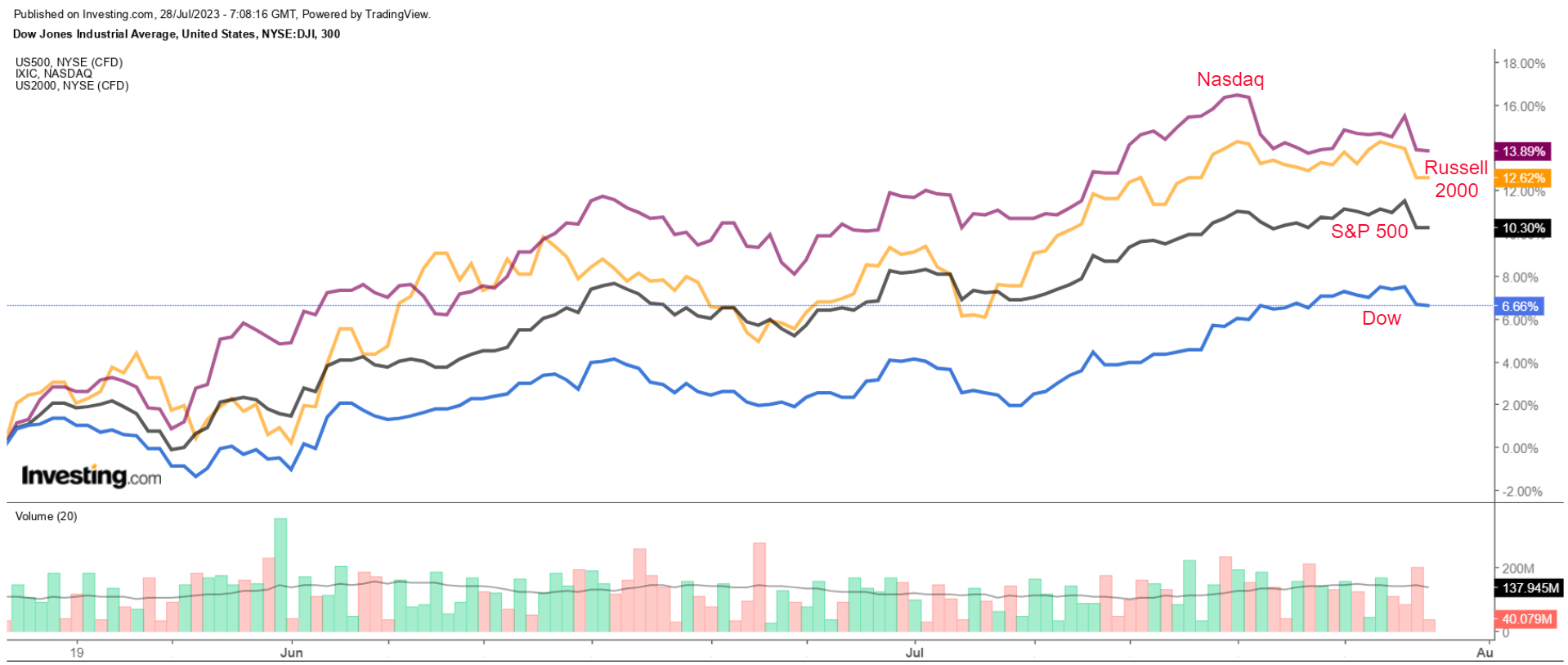 But as July comes to an end, investors should prepare themselves for fresh volatility in August, which has a reputation for being a relatively weak month for the stock market.
But as July comes to an end, investors should prepare themselves for fresh volatility in August, which has a reputation for being a relatively weak month for the stock market.
In fact, August has been the U.S. stock market’s worst month on average, dating back to 1986. The Dow’s average August return over the past 35 years is negative -0.67%, compared to an average gain of +1.05% for the other months of the calendar.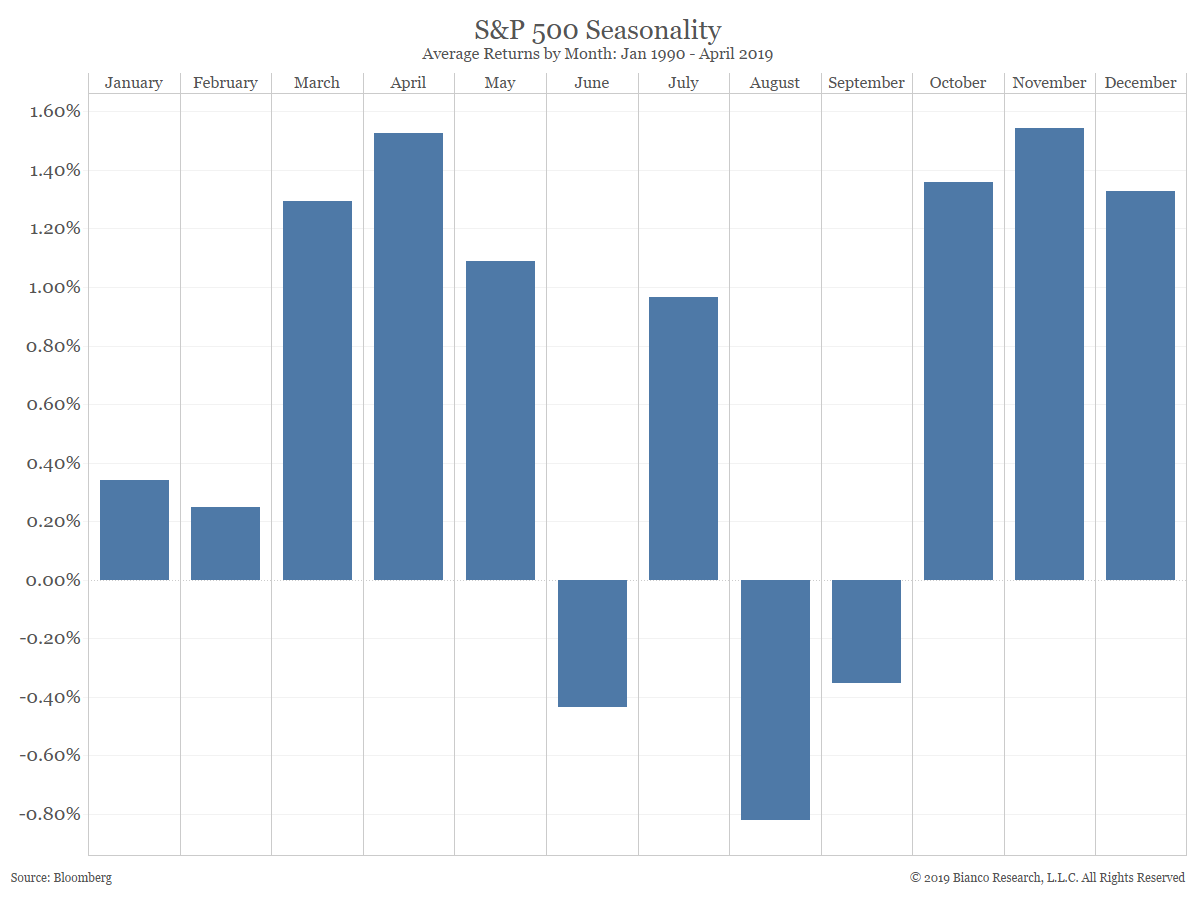
Source: Bloomberg, Bianco Research
With investors continuing to gauge the outlook for interest rates, inflation, and the economy, a lot will be on the line in the month ahead. As such, here are key dates to watch as the calendar flips to August:
1. U.S. Jobs Report: Friday, August 4
The first big piece of data to come out after the Fed’s policy meeting will be the U.S. jobs report and it will likely be key in determining the U.S. central bank’s next move.
The Labor Department will release the highly anticipated July jobs report on Friday, August 4, at 8:30 AM ET. Forecasts center around a continued solid pace of hiring, even if the increase is smaller than in previous months.
The consensus estimate is that the data will show the U.S. economy added 190,000 positions, according to Investing.com, slowing from jobs growth of 209,000 in June.
The unemployment rate is seen holding steady at 3.6%, staying close to a recent 53-year low of 3.4%. Fed officials have signaled in the past that the jobless rate needs to be at least 4.0% to slow inflation.
To put things in context, the unemployment rate stood at 3.5% exactly one year ago in July 2022, suggesting that the Fed still has room to lift rates.
Meanwhile, average hourly earnings are expected to rise 0.3% month-over-month, while the year-over-year rate is forecast to increase 4.3%, which is still too hot for the Fed.
Prediction:
2. U.S. CPI Data: Thursday, August 10
The July consumer price index report looms large on Thursday, August 10, at 8:30 AM ET and the numbers will likely show that inflation continues to run well above the Fed’s 2% target.
While no official forecasts have been set yet, expectations for annual CPI range from an increase of 2.7% to 2.9%, compared to a 3.0% annual pace in June.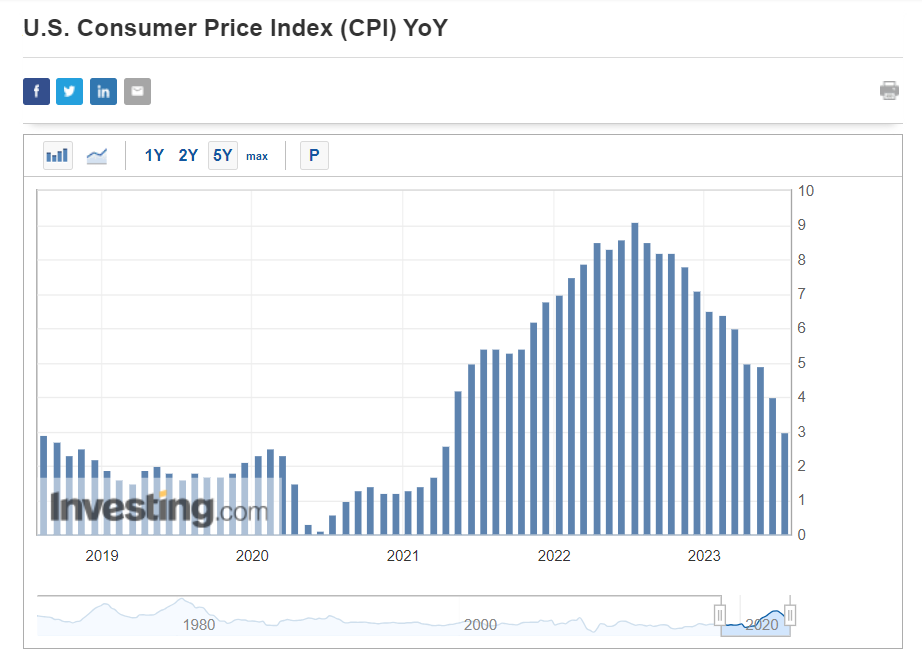
The headline annual inflation rate peaked at a 40-year high of 9.1% last summer, and has been on a steady downtrend since, however prices are still rising at a pace well above the Fed’s 2% target range.
Meanwhile, estimates for the year-on-year core figure - which does not include food and energy prices - center around 4.6%-4.7%, compared to June’s 4.8% reading.
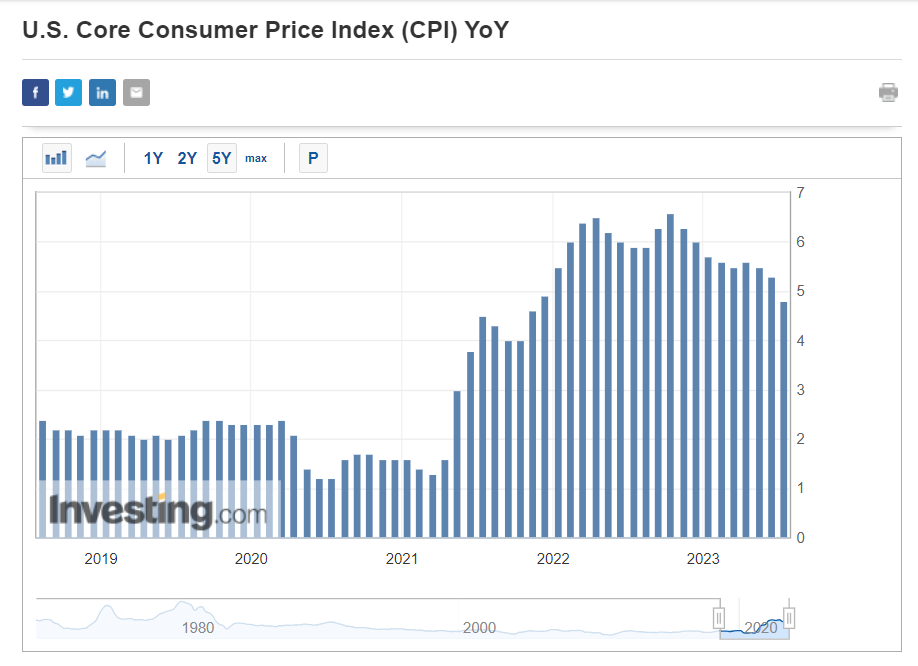
The underlying core number is closely watched by Fed officials who believe that it provides a more accurate assessment of the future direction of inflation.
Prediction:
A surprisingly strong reading, in which the headline CPI number comes in at 3% or above, will keep pressure on the Fed to maintain its fight against inflation.
3. Fed’s Jackson Hole Symposium: Thursday-Saturday, August 24-26
An annual meeting of top central bankers and economists hosted by the Federal Reserve Bank of Kansas City in Jackson Hole, Wyoming, is set to take place from Thursday, August 24 to Saturday, August 26.
While the tentative list of speakers has yet to be finalized, Fed chairs have in the past used their keynote speech at Jackson Hole to signal future U.S. central bank policy moves.
The Fed resumed its rate hike cycle this week by lifting its benchmark interest rate by a widely expected 25 basis points to the highest levels in more than two decades, and the accompanying policy statement left the door open to another increase.
The rate hike, the Fed's 11th in its last 12 meetings, set the Fed Funds rate in the 5.25%-5.50% range, the highest since January 2001.
The Fed’s statement reiterated that policymakers would watch incoming data “in determining the extent of additional policy firming that may be appropriate" to reach its 2% inflation target.
Chair Powell said in a press conference the Fed will make data-driven decisions on a “meeting-by-meeting” basis and it's possible the central bank will follow its latest rate rise with another one at the policy meeting scheduled for September.
"It is certainly possible we would raise the funds rate at the September meeting if the data warranted, and I would also say it's possible that we would choose to hold steady at that meeting" if that's what the data called for, Powell said.
As of Friday morning, financial markets are pricing in a 22% chance of a 25-basis point rate increase at the Fed’s next policy meeting in September and a 78% chance of no action, according to the Investing.com Fed Rate Monitor Tool.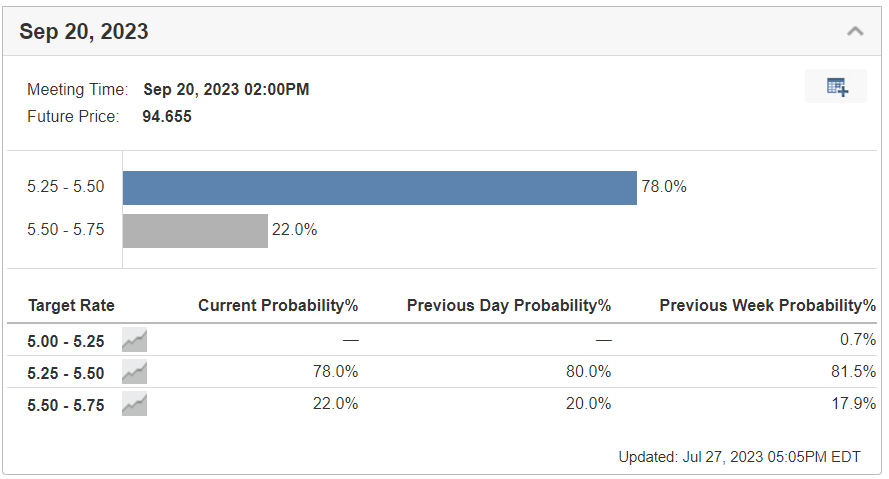
Source: Investing.com
Prediction:
4. Earnings Season Continues
Investors await a flood of earnings in August as Wall Street’s second-quarter reporting season continues.
Apple (NASDAQ:AAPL) and Amazon (NASDAQ:AMZN) will be the last ‘FAAMG’ companies to report quarterly results when they both release their earnings after the market closes on Thursday, August 3. Both mega-cap tech names have seen their shares significantly outperform the broader market this year, with AAPL climbing 48.7% and AMZN up 52.6%.
Other notable companies joining Apple and Amazon in reporting earnings next week include Advanced Micro Devices (NASDAQ:AMD), Qualcomm (NASDAQ:QCOM), Cloudflare (NYSE:NET), Fortinet (NASDAQ:FTNT), PayPal (NASDAQ:PYPL), Block, Coinbase (NASDAQ:COIN), Robinhood (NASDAQ:HOOD) Markets, DraftKings (NASDAQ:DKNG), Shopify (NYSE:SHOP), Pinterest (NYSE:PINS), Etsy (NASDAQ:ETSY), Airbnb, and Expedia (NASDAQ:EXPE).
Starbucks (NASDAQ:SBUX), Kraft Heinz (NASDAQ:KHC), Anheuser-Busch InBev, CVS Health (NYSE:CVS), Moderna (NASDAQ:MRNA), ConocoPhillips (NYSE:COP), Occidental Petroleum (NYSE:OXY), and Devon Energy (NYSE:DVN) are also on the agenda.
The following week sees high-profile names like Walt Disney (NYSE:DIS), United Parcel Service (NYSE:UPS), Eli Lilly (NYSE:LLY), Palantir Technologies (NYSE:PLTR), Trade Desk (NASDAQ:TTD), Datadog (NASDAQ:DDOG), Roblox (NYSE:RBLX), Lucid Group (NASDAQ:LCID), Rivian Automotive (NASDAQ:RIVN), Tyson Foods (NYSE:TSN), and AMC Entertainment (NYSE:AMC) report earnings.
Retailers then take center stage when heavyweights Walmart (NYSE:WMT), Target (NYSE:TGT), Home Depot (NYSE:HD), Lowe’s (NYSE:LOW), TJX Companies (NYSE:TJX), and Costco (NASDAQ:COST) deliver their latest financial results.
Another key name to watch will be Nvidia (NASDAQ:NVDA), whose Q2 results are scheduled to come out after the closing bell on Wednesday, August 23. Shares of the Santa Clara, California-based tech giant have soared 214% year-to-date, rising alongside spiking interest in Artificial Intelligence (AI) advancements.
Second-quarter earnings season is nearly halfway through. Of the 219 S&P 500 companies that have reported through Friday, about 78% have topped expectations, according to FactSet data. In a typical quarter, 73% of S&P 500 companies beat estimates.
***
Disclosure: At the time of writing, I am long on the on the Dow Jones Industrial Average, S&P 500, and the Nasdaq 100 via the SPDR Dow ETF (DIA), SPDR S&P 500 ETF (SPY (NYSE:SPY)), and the Invesco QQQ Trust ETF (QQQ). I am also long on the Technology Select Sector SPDR ETF (NYSE:XLK).
I regularly rebalance my portfolio of individual stocks and ETFs based on ongoing risk assessment of both the macroeconomic environment and companies' financials. The views discussed in this article are solely the opinion of the author and should not be taken as investment advice.
